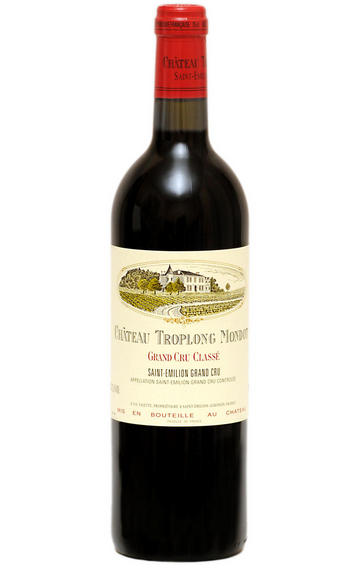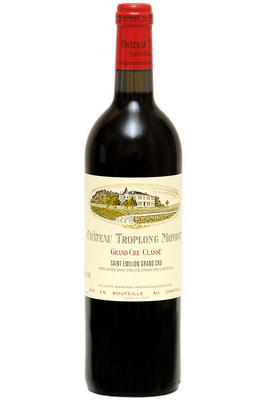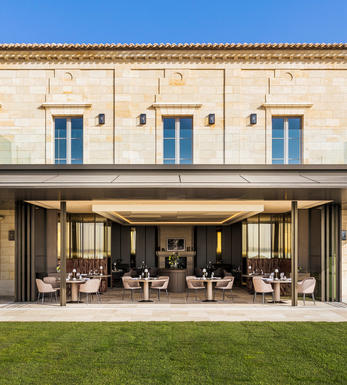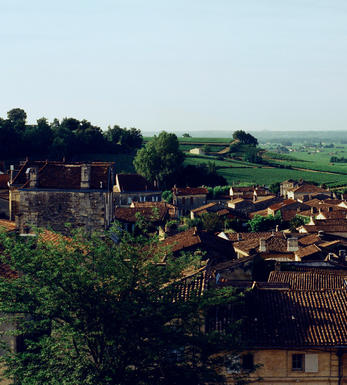
2005 Château Troplong Mondot, St Emilion, Bordeaux

Critics reviews
The 2005 Troplong Mondot is a heady, sumptuous beauty. Sweet black cherry, plum, chocolate, spice, new leather, liquorice, and menthol are all open in the glass. Hedonistic and opulent to the core, the 2005 is a decidedly exuberant Saint-Émilion. I would open it a few hours in advance, as aeration helps soften some of the initial flamboyance.
The 2005 is a gorgeous, captivating wine. It is modern Saint-Émilion at its finest. Moreover, it does not appear to have lost much, if anything, since the last time I tasted it a few years ago!
Drink 2021 - 2034
Antonio Galloni, Vinous.com (April 2021)
The 2005 Troplong Mondot is a blend of 90% Merlot and the rest Cabernet Franc. It was emotional tasting this wine, thinking of the late Christine Valette, who made this compelling wine while battling with considerable courage against an insidious disease. It is a great effort and a superstar of the vintage.
Dense purple, it offers notes of white chocolate, blackberry, cassis and liquorice, as well as a hint of truffle and some subtle background oak. Full-bodied, multi-layered, and spectacularly pure and rich, it is a tour de force and a great tribute to an incredible woman. Remarkably youthful, this wine probably needs another 4-8 years of bottle age, and should keep for 20 or more years. Kudos to the late Christine Valette!
Drink 2019 - 2043
Robert M. Parker, Jr., Wine Advocate (June 2015)
Full ruby-red. The spectacularly ripe nose offers plum jam, minerals, liquorice, mocha and a whiff of game, all lifted by exotic flowers. Explosively ripe and sweet in the mouth, with uncanny fullness and depth to the flavours of raspberry, smoke and milk chocolate. It is a blockbuster of a wine with a three-dimensional texture and outstanding weight but with almost magically ripe acidity, giving great precision to the flavours and drawing out the finish. Incredible melting tannins saturate the palate and front teeth. Wonderfully suave wine, the best I've ever tasted from this chateau.
The 2007 harvest on this cold plateau east of St. Emilion took place very late, from October 9 through 19, and cellarmaster Jean-Pierre Taleyson told me that 30% of the crop was eliminated in the vines. In fact, he noted, the harvesting team actually made five passes through the vines to pick with the greatest possible precision. A 15% saignee was done to concentrate the must, compared to 20% in 2006.
Stephen Tanzer, Vinous.com (May 2008)
About this WINE

Château Troplong Mondot
Château Troplong Mondot is a St. Emilion Premier Grand Cru Classé property that has in the last decade been producing wines that are the equal of many 1er Grand Cru Classé estates. Its handsome château dates back to 1745 and Troplong-Mondot was originally part of one sizeable domaine which included the vineyards of Château Pavie. It became autonomous in 1850 when it was acquired by Raymond Troplong. Later on, it was bought by Alexandre Valette and today it is owned and run by his great-granddaughter, Christine and her husband Xavier Pariente.
Troplong Mondot has 30 hectares of vineyards well-sited alongside the hill of Mondot to the north-east of the St-Emilion appellation. The soils are rich in limestone clay and are planted with Merlot (90%), Cabernet Franc (5%) and Cabernet Sauvignon (5%). The grapes are hand-harvested and then fermented in temperature-controlled, stainless steel tanks. The wine is then aged in oak barriques (75% new) for 18 months. It is bottled unfiltered.
Guru oenologist Michel Rolland has been a consultant at Troplong Mondot since the mid 1980s.

St Émilion
St Émilion is one of Bordeaux's largest producing appellations, producing more wine than Listrac, Moulis, St Estèphe, Pauillac, St Julien and Margaux put together. St Emilion has been producing wine for longer than the Médoc but its lack of accessibility to Bordeaux's port and market-restricted exports to mainland Europe meant the region initially did not enjoy the commercial success that funded the great châteaux of the Left Bank.
St Émilion itself is the prettiest of Bordeaux's wine towns, perched on top of the steep limestone slopes upon which many of the region's finest vineyards are situated. However, more than half of the appellation's vineyards lie on the plain between the town and the Dordogne River on sandy, alluvial soils with a sprinkling of gravel.
Further diversity is added by a small, complex gravel bed to the north-east of the region on the border with Pomerol. Atypically for St Émilion, this allows Cabernet Franc and, to a lesser extent, Cabernet Sauvignon to prosper and defines the personality of the great wines such as Ch. Cheval Blanc.
In the early 1990s there was an explosion of experimentation and evolution, leading to the rise of the garagistes, producers of deeply-concentrated wines made in very small quantities and offered at high prices. The appellation is also surrounded by four satellite appellations, Montagne, Lussac, Puisseguin and St. Georges, which enjoy a family similarity but not the complexity of the best wines.
St Émilion was first officially classified in 1954, and is the most meritocratic classification system in Bordeaux, as it is regularly amended. The most recent revision of the classification was in 2012

Cabernet Sauvignon Blend
Cabernet Sauvignon lends itself particularly well in blends with Merlot. This is actually the archetypal Bordeaux blend, though in different proportions in the sub-regions and sometimes topped up with Cabernet Franc, Malbec, and Petit Verdot.
In the Médoc and Graves the percentage of Cabernet Sauvignon in the blend can range from 95% (Mouton-Rothschild) to as low as 40%. It is particularly suited to the dry, warm, free- draining, gravel-rich soils and is responsible for the redolent cassis characteristics as well as the depth of colour, tannic structure and pronounced acidity of Médoc wines. However 100% Cabernet Sauvignon wines can be slightly hollow-tasting in the middle palate and Merlot with its generous, fleshy fruit flavours acts as a perfect foil by filling in this cavity.
In St-Emilion and Pomerol, the blends are Merlot dominated as Cabernet Sauvignon can struggle to ripen there - when it is included, it adds structure and body to the wine. Sassicaia is the most famous Bordeaux blend in Italy and has spawned many imitations, whereby the blend is now firmly established in the New World and particularly in California and Australia.


Buying options
Add to wishlist
Description
The 2005 Troplong Mondot is a heady, sumptuous beauty. Sweet black cherry, plum, chocolate, spice, new leather, liquorice, and menthol are all open in the glass. Hedonistic and opulent to the core, the 2005 is a decidedly exuberant Saint-Émilion. I would open it a few hours in advance, as aeration helps soften some of the initial flamboyance.
The 2005 is a gorgeous, captivating wine. It is modern Saint-Émilion at its finest. Moreover, it does not appear to have lost much, if anything, since the last time I tasted it a few years ago!
Drink 2021 - 2034
Antonio Galloni, Vinous.com (April 2021)
wine at a glance
Delivery and quality guarantee